The Best Orthotics for Kids – The Solution to Your Kids’ Foot and Leg Pain!
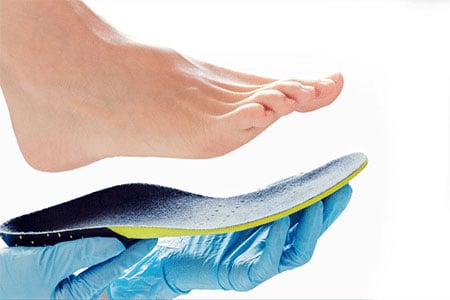
Has your child been complaining about foot or leg pain? The most common reason why children experience foot and leg pain is from having flat feet or other foot conditions such as rolled ankles, low muscle tone, hypermobility, overpronation, toe walking, etc. The good news is that certain orthotics can significantly reduce or fully eliminate your child’s foot and leg pain. Let’s take a look at the best orthotics for kids with foot or leg pain.
When children are flat-footed their feet collapse and turn inwards, throwing the child’s body out of alignment. Did you know that flat feet can lead to long-term lower body conditions if not corrected in time?
I always recommend parents to be proactive and don’t take the “wait and see approach” when it comes to treating their children’s foot conditions. Leaving your children’s foot conditions untreated can only lead to the condition getting worse.
Wearing a pair of orthotics is one of the most effective ways to help treat and correct your child’s foot condition. The orthotics I recommend have proven to significantly reduce or fully eliminate the pain associated with flat feet. They will prevent your child’s feet from collapsing and improve your child’s overall posture. However, don’t take my word for it, let me prove this to you!
The Best Orthotics for Kids — What a Difference These Orthotics Can Make!
Let’s start by taking a look at the picture of a flat-footed child standing barefoot. Do you notice how the child’s feet are collapsing and turning inwards?

Now notice how much straighter the child’s feet are when standing in a pair of the orthotics I recommend. The orthotics are preventing her feet from collapsing and turning inwards:
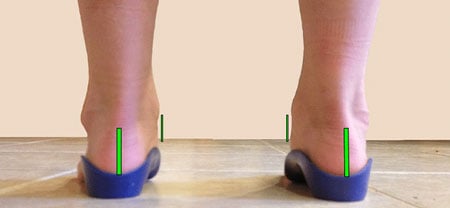
Do you notice what a positive impact orthotics can have? I have helped several children with flat feet who were overpronating walk and run much straighter.
Before I show you a selection of the best orthotics for kids to help treat and correct these foot conditions, let’s take a look at what features the orthotics I recommend provide.
What Makes the Orthotics that I Recommend the Best Choice for Kids?
1️⃣ Built-In Arch: This feature is going to prevent your child’s feet from collapsing and turning inwards. The orthotic also provides shock absorption to minimize the impact that your kids’ feet take when they come in contact with the ground.
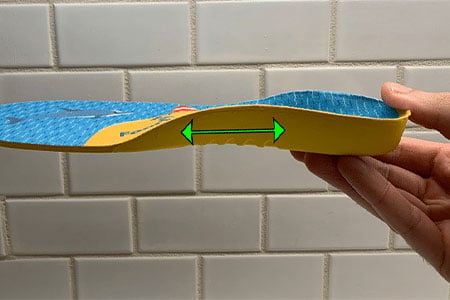
2️⃣ Built-In Heel Cup: This feature is going to help strengthen and straighten your child’s ankles.
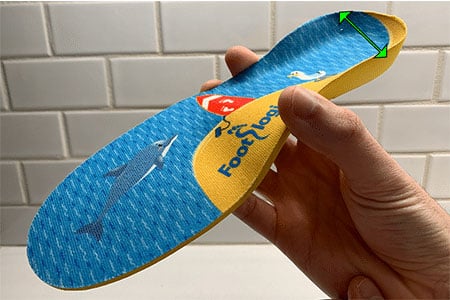
3️⃣ The orthotic is designed to mold over time to fit each child’s unique foot.
4️⃣ Fits most roomy footwear styles with factory insoles you can remove.
5️⃣ Natural NXT anti-bacteria coating, latex-free & vegan.
6️⃣ Durable construction adds comfort, support & structure to shoes.
The main reason why I recommend this orthotic is that it provides excellent arch and heel support, and at the same time is not as invasive as other orthotics. This means that this orthotic allows the child’s foot and leg muscles to develop on their own while supporting them.
Now that you know what features the orthotics I recommend provide, you are ready to take a look at the best orthotics for kids. I only write reviews of orthotics that I have fitted before, otherwise, I wouldn’t know how well-made they are and the amount of support that they provide.
The Best Orthotics for Kids with Mild Pronation
The orthotic below works best for children with flat feet and mild cases of pronation.
Fits Toddler Shoe Size 5 up to Big Kid Shoe Size 3
- Fits a toddler shoe size 5 up to a big kid shoe size 3
- Medically approved insoles with targeted cushion and support
- Deep heel cup with strong arch support
- Made from lightweight yet supportive cushioning material with shock-absorbing heel and forefoot padding
- They can be trimmed to size with scissors if needed
Do You Need to Remove the Original Insoles of the Shoes?
Yes, I suggest that you remove the original insoles of your child’s shoes before placing this orthotic inside the shoes.
This type of orthotic is one of the most recommended by pediatricians and podiatrists to prevent overpronation. It has been specifically developed by podiatrists for treating kids who suffer from flat feet, rolled ankles, and overpronation. One of the greatest advantages of this orthotic is how it can be fitted in most shoes including school shoes, sports shoes and dress shoes.
The Best Orthotics for Kids with Moderate or Strong Pronation
The orthotic below works best for children with flat feet and moderate or strong cases of pronation, and it can also help treat rolled ankles, low muscle tone, knock knees, and toe walking.
1️⃣ Deep heel cup that helps control the alignment of the heel and lower leg.
2️⃣ Medial and lateral flanges to help keep the foot aligned over the orthotic.
You Must Enter a Referral Code to Order this Orthotic
To place an order for littleSTEPS® Orthotics, you must submit a Referral Code in the Discount Window during the ordering process: JVFCS100121
Do You Need to Remove the Original Insoles of the Shoes?
No, you won’t have to remove the original insoles of your child’s shoes before placing this orthotic inside the shoes.
Take a look at the chart below to figure out what size to order based on your child’s shoe size:
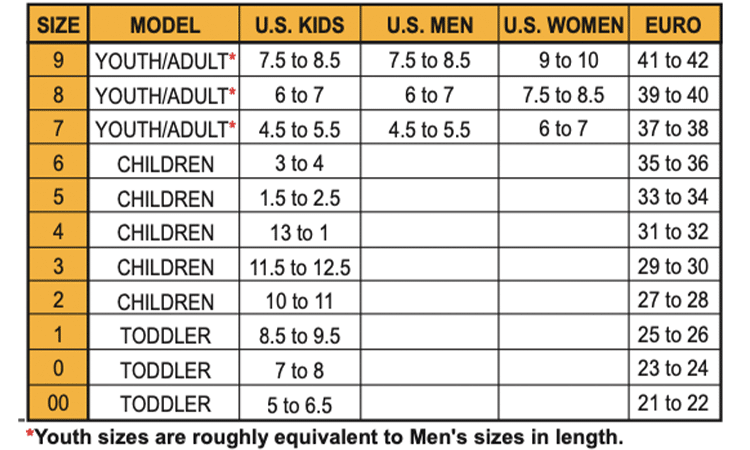
How effective these orthotics will be in re-aligning your child’s feet and improving your child’s walking gait and overall posture depends directly on the degree of your child’s foot condition.
Keep in mind that the orthotics and the shoes work together in trying to properly align your kids’ feet and legs. If you stand your child in the orthotics and you still notice that the feet are collapsing, wait until you fit the orthotics inside the shoe and watch them walk.
The Best Kids’ Shoes for Orthotics – The 5 Must-Have Features!
If you already have the correct type of orthotic for your child, then it’s time to find the correct type of shoes. These are the 5 most important features that your kids’ shoes must provide to be able to accommodate an orthotic:
1️⃣ Substantial Outsole: For the shoe to hold the orthotic in place and support your kids’ feet, the shoe must provide a substantial, supportive outsole. Below you can see the difference between a shoe with a substantial outsole versus a shoe with an outsole that is too thin and won’t provide the correct amount of support:
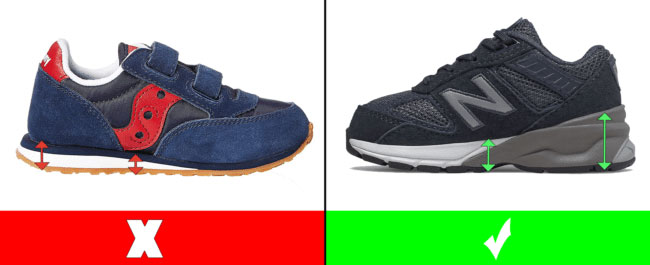
2️⃣ Lightweight and Flexible: While we want the shoes to be supportive, the shoes must be lightweight and flexible at the same time to prevent your kids’ feet and legs from easily getting tired. Your kids’ shoes should always bend at the ball of the foot but no further. It’s important for your kids’ shoes to be flexible but not too flexible otherwise they won’t provide enough support. The picture below shows the difference between a shoe that is too flexible versus a shoe that provides the correct amount of flexibility:
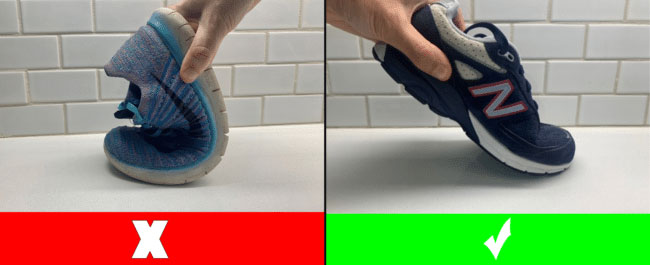
3️⃣ Firm Heel Counter: The heel counter of the shoe is the part of the shoe that provides ankle support. If you provide your child with a heel counter that is too soft, your child won’t get any of the benefits that the orthotics have to offer.

4️⃣ Extra Depth: Shoes that provide extra depth allow the orthotic to fit deeply inside the shoes, which helps prevent the top part of your kids’ feet from rubbing against the top part of the shoes. Orthotics can take up a lot of extra space inside the shoes, and some of them take up more space than others. Let me show you the difference between a pair of deep shoes versus one that is not. For better visualization purposes, the orthotic below is fitted inside the shoes.

5️⃣ Removable Insoles: If the shoes that you provide for your child don’t come with a removable insole, it’s highly likely that you won’t be able to fit the orthotic inside the shoes. When you remove the original insole of the shoe, you are allowing extra space to fit the orthotic inside the shoe. If you leave the original insole inside the shoes and fit the orthotic on top, you will be raising your children’s feet, making them rub against the top of the shoes and giving your children the impression that their feet are coming out of the shoe.
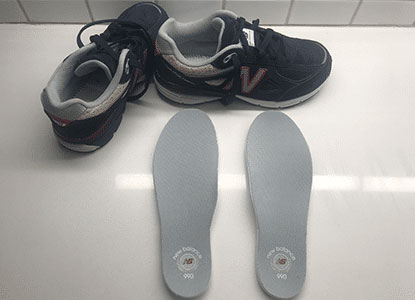
What Shoes Work Best with Orthotics?
Here you can access a selection of the best kids’ shoes for orthotics that are supportive and provide extra depth.
How to Tie Shoes with Orthotics? – The Most Effective Method!
It is always better to provide your child with a pair of shoes that come with shoelaces instead of velcro closure. Shoelaces allow the shoe to “hug” your kids’ feet in a more effective way than velcro sneakers.
There is actually a shoe tying method that has proven to be the most effective one for children who wear orthotics.
How to Tell If a Child Needs to Wear Orthotics? – Let’s Find Out!
If your child has been complaining about foot and leg pain and you notice a change in your child’s walking gait, I recommend taking your child to a pediatrician or physical/occupational therapist.
Keep in mind that we all have a certain degree of pronation or supination. However, when pronation or supination becomes excessive, children might start complaining about their feet and legs hurting. How can you tell if your child is pronating excessively?
There are two ways parents can check from home if their child can be a candidate for orthotics.
1️⃣ First Method: Take a look at your child’s feet while standing barefoot and check whether you notice an arch below your kids’ feet:
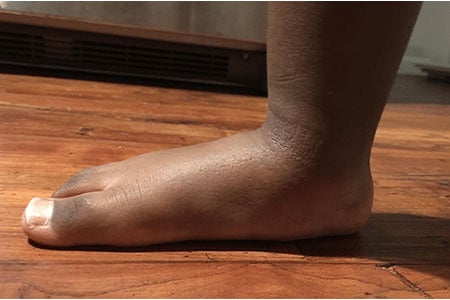
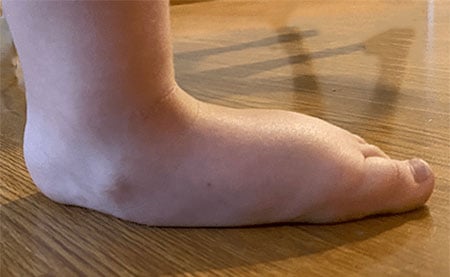
2️⃣ Second Method: Take a look at the shoes that your child has been wearing, and you will be able to notice if the shoes are caving in or not. For this method to work your child should have worn the shoes for 2 to 3 months.
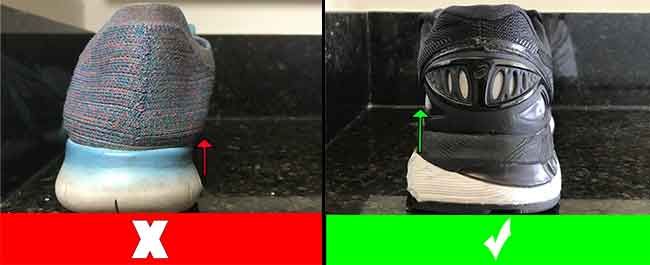
Every time your children overpronate they are developing an abnormal walking and running pattern. If you don’t take care of this issue from an early stage, this overpronation may cause severe foot and leg pain in the short term and will result in other painful conditions as your child grows such as Sever’s Disease (heel pain), knee pain, and aching legs.
Is there another type of orthotic that has worked well for your kids’ feet? Please share your thoughts and findings below so other parents can benefit from your experiences.




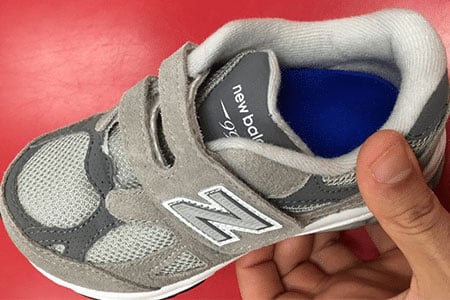

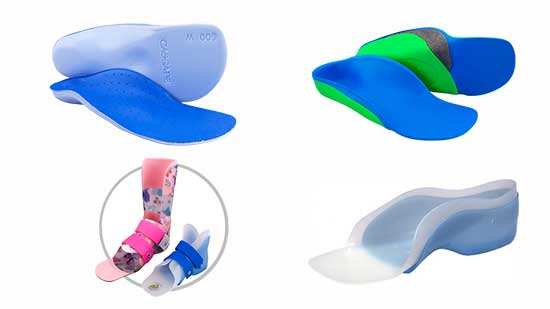
Is there any over the counter orthotics or arch support insole you can recommend for my 6 year old son that has flat feet?
Hello Joyce,
Yes, have you tried Superfeet insoles before? They come in different colors based on the amount of support that they provide.
Your son should start by trying the green one:
Superfeet Insole
You might have to trim it to fit it in your son’s shoes, and don’t forget to remove the original insoles of the shoes.
Hello Joyce,
Yes, have you tried Superfeet insoles before? They come in different colors based on the amount of support that they provide.
Your son should start by trying the green one:
Superfeet Insole
You might have to trim it to fit it in your son’s shoes, and don’t forget to remove the original insoles of the shoes.
Thank for your articles. I be noticed my kid has been instinctively cracking her ankle , at night at age 3. I have been looking for some good shoe recommendation. Your articles have been a great help.
Hello Marj,
I am glad that you found the website informative! Were you able to find a shoe style for your child?